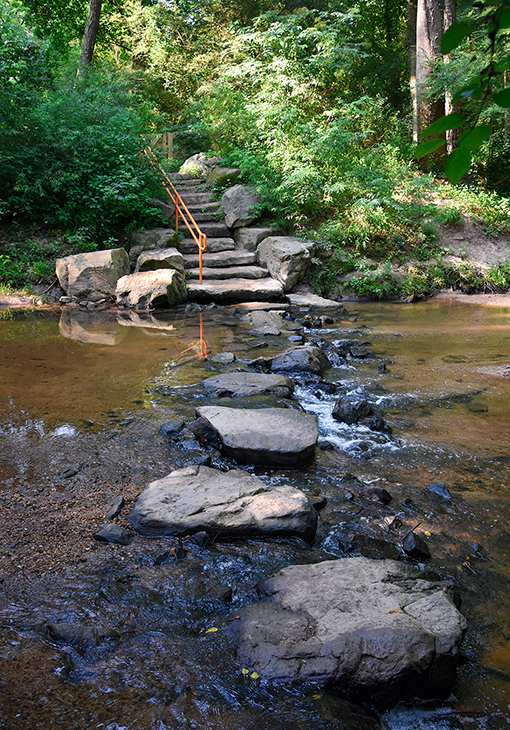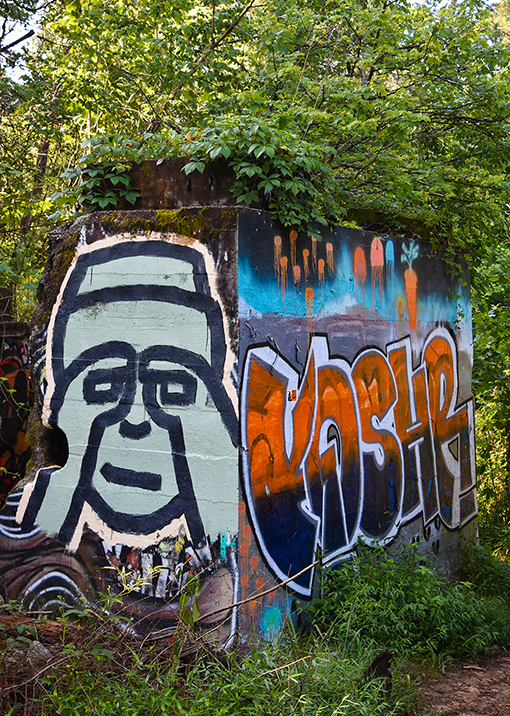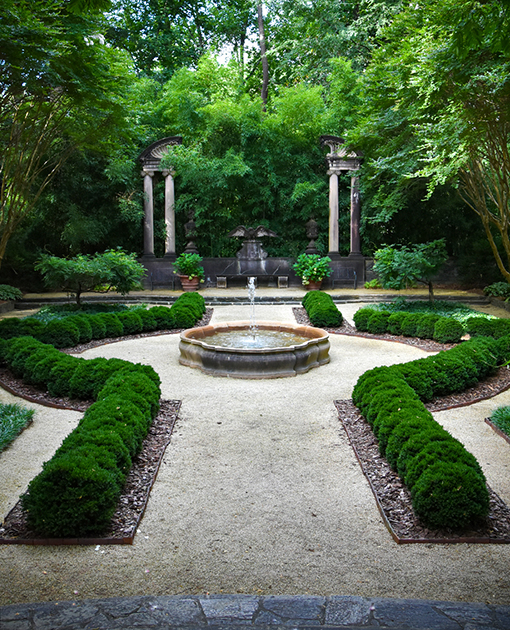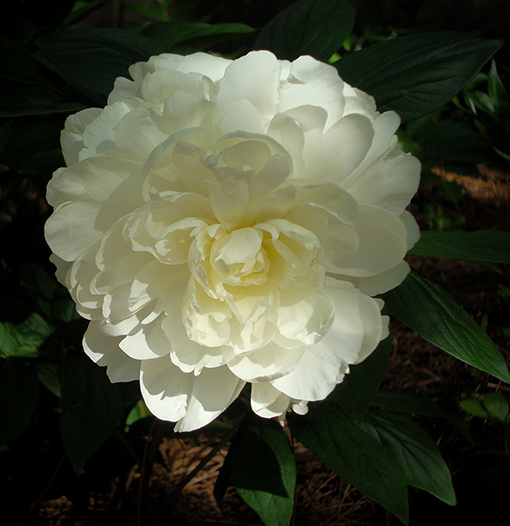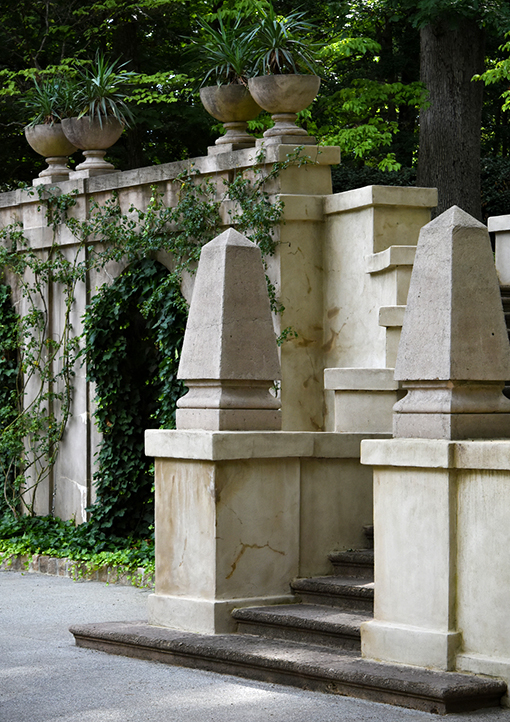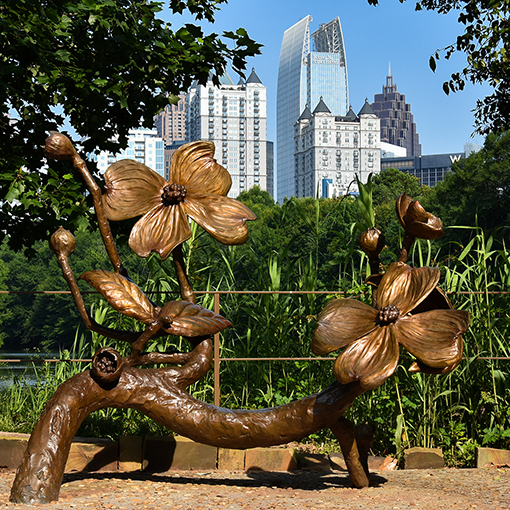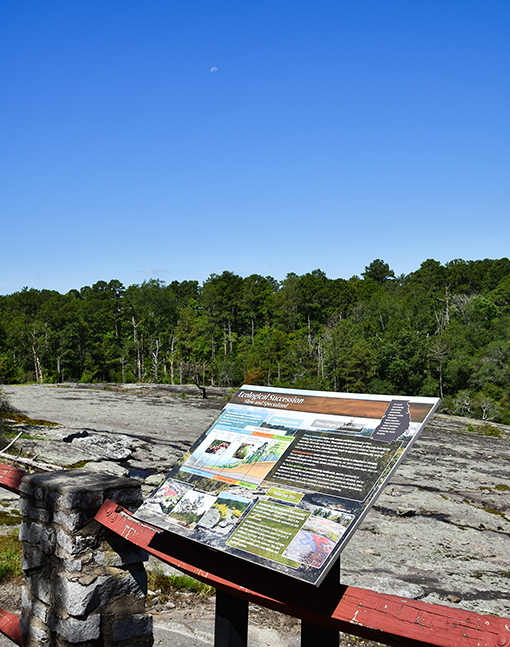 |
| Three Creeks Trail | Photo: Travis Swann Taylor |
I'm not sure when the Old Decatur Waterworks became a canvas for graffiti artists/urban artists, but it certainly is attention-grabbing! A lot of it is delightful, some of it is thought-provoking, and some of it contains "language", not Rated-G language either. Be prepared to answer certain questions if you bring the little ones here. Or, zip past this and continue with your exploration of nature and a few surprises!
This is the pylon you're looking for!
This is the beginning of Three Creeks Trail. On one side of the pylon is a map of the trail. Go ahead and snap a photo of the map with your phone. On the other side is information about the former Native American residents. Cherokee and Creek Indians lived on these lands, as did other Native Americans dating as far back as 10,000 years ago!
What are the namesake three creeks you ask? There's South Fork Peachtree Creek (the larger of the three), Burnt Fork Creek, and Glenn Creek. Three Creeks Trail runs south of the 180° turn of the treetop boardwalk on South Peachtree Creek Trail. If you're traveling from the Medlock Park trail head, you'll enter Three Creeks Trail before you get to the 180° turn.
There are more than a dozen structures here! Among them are large and small circular water tanks—they have water in them, but don't bother bringing your bathing suit. There's an administration building, and there are two rectangular settling tanks.
This Waterworks provided water to the City of Decatur until the late 30s, around 1939, according to my research. It continued to serve as a backup once the new facility went operational. This area also served as a public park for a period, until it was closed to the public during World War II.
Old Decatur Waterworks was entered in the National Register of Historic Places in 2006, 100 years after construction started on the first structure, the Administration Building! It was recognized for its significance in the areas of politics and government, entertainment and recreation, and landscape architecture.
I didn't explore Three Creeks Trail the first time I traveled South Peachtree Creek Trail. There are some really fun sights to see, including the 180° turnaround on the treetop boardwalk from far below. Back on South Peachtree Creek Trail, on this part of the boardwalk, is where you'll see the popular water tower.
I don't think I realized how high I was the first time I was on this section of treetop boardwalk. I was distracted by the design of the boardwalk and seeing the "famous" water tower I'd heard about.
I encourage you to look around while you're exploring...look all around! This particular path goes in a big circle, so you don't have the reverse view unless you decided to double-back.
This part of the trail has gates on both sides of the creek, with signage encouraging caution when crossing here, warning about slippery rocks. And the bright orange hand rails are awesome! I'm sure they come in handy around dusk.
There were plenty of dry spots on the rocks that I could see—and I'm mindful that the slippery could be on my shoes from mud I'd stepped in before getting to the rocks—I was more concerned that the rocks might not be secure. I really didn't want to swim around in the creek. I passed slowly and safely.
When I was a kid, there was a time when we lived in the mountains—I've lived in the Smoky Mountains and the Rocky Mountains. Both gave me a love of nature that you just don't get living only in the city. Don't get me wrong, I'm totally a city guy, but I have a high regard and respect for nature, a gift received by spending so much time in forests and mountains.
This I found particularly cool. I've seen stone-lined creek beds before, but I'd never seen one done more like cobblestone. I think this is beautiful. I wouldn't want to ride my bike over it (and it's not on the main path), but of course I walked over it. These kinds of surprises delight me to no end.
"Like music and art, love of nature is a common language that can transcend political or social boundaries.”
— Jimmy Carter
He's so tiny that you might not be able to make out his sign. It says, "Gnome, Sweet Gnome". I assume this was left by a neighbor—it's very close to the Desmond Drive at Park Lane entrance to the trail. What a delightful little surprise to find so unexpectedly.
Three Creeks Trail is a fun diversion off of the South Peachtree Creek Trail. I hope you'll make the time to explore it, a totally different experience from the main trail! The second half of the trail is more tranquil, albeit less flat. There are a few minor but interesting rock outcrops, lots of undergrowth, and you'll see terrain that's totally different from any part of South Peachtree Creek Trail.
The loop closes back at the Old Decatur Waterworks, but on its other side, so you'll get to see quite a bit of those ruins, if you didn't already explore them extensively.
I enjoy graffiti art/urban art and Atlanta has truly embraced it as an art form. But, while most of the graffiti artists in Atlanta create their art respectfully and tastefully, others leave trash behind—the kind that someone else has to pick up. It's not only rude, it's disrespectful...to the environment and everyone else who would like to enjoy nature.
Some of this trash I assume is left by visitors, not all of it by some of the artists. Paint away, just take your trash with you! Oh, and painting on directional signs (which creates dangerous situations) or educational signs is a total loser move. Stick to the ruins, please!
Please help spread the word about the Leave No Trace initiative. Why? So that we all, and future generations, can enjoy our parks, hiking trails, and other nature spots. It's up to us!
This link has a photograph of the Old Decatur Waterworks from the 1940s, which can help orient you to what you'll explore when you go hiking on the Three Creeks Trail. Remember, this one is a trail inside a trail. You get to it from the South Peachtree Creek Trail.
Go, enjoy nature, enjoy the ruins of the Old Decatur Waterworks, enjoy some awesome graffiti art, and look around for delightful surprises along your outdoor adventure.




